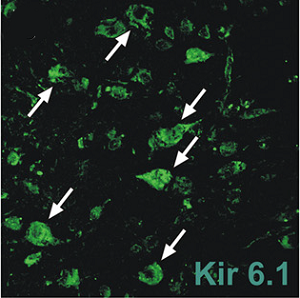Overview
- Peptide (C)KRNSMRRNNSMRRSN, corresponding to amino acid residues 382-396 of rat Kir6.1 (Accession Q63664). Intracellular, C-terminal part.

 Western blot analysis of rat heart membranes:1. Anti-Kir6.1 (KCNJ8) Antibody (#APC-105), (1:200).
Western blot analysis of rat heart membranes:1. Anti-Kir6.1 (KCNJ8) Antibody (#APC-105), (1:200).
2. Anti-Kir6.1 (KCNJ8) Antibody, preincubated with Kir6.1/KCNJ8 Blocking Peptide (#BLP-PC105). Western blot analysis of rat cortex lysate:1. Anti-Kir6.1 (KCNJ8) Antibody (#APC-105), (1:200).
Western blot analysis of rat cortex lysate:1. Anti-Kir6.1 (KCNJ8) Antibody (#APC-105), (1:200).
2. Anti-Kir6.1 (KCNJ8) Antibody, preincubated with Kir6.1/KCNJ8 Blocking Peptide (#BLP-PC105).- Human umbilical vein segment lysate (Protić, D. et al. (2014) Phytother. Res. 28, 1412.).
- Mouse heart lysate (Li, J. et al. (2010) J. Biol. Chem. 285, 28723.).
 Expression of Kir6.1 in rat uterusImmunohistochemical stain of pregnant rat longitudinal section of the myometrium using Anti-Kir6.1 (KCNJ8) Antibody (#APC-105), (1:50). Strong and specific staining is evident in smooth muscles cells both in the myometrium (blue arrow) and muscular layers of blood vessels (green arrow). Peroxidase reaction with DAB were used for the color reaction. Hematoxilin is used as the counterstain.
Expression of Kir6.1 in rat uterusImmunohistochemical stain of pregnant rat longitudinal section of the myometrium using Anti-Kir6.1 (KCNJ8) Antibody (#APC-105), (1:50). Strong and specific staining is evident in smooth muscles cells both in the myometrium (blue arrow) and muscular layers of blood vessels (green arrow). Peroxidase reaction with DAB were used for the color reaction. Hematoxilin is used as the counterstain.- Mouse brain sections (1:100) (Parsons, M.P. and Hirasawa, M. (2010) J. Neurosci. 30, 8061.).
- Baukrowitz, T. and Fakler, B. (2000) Eur. J. Biochem. 267, 5842.
- Aguilar-Bryan, L. et al. (1998) Physiol. Rev. 78, 227.
Kir6.1 is a member of the inward rectifier K+ channels (Kir channels), a large family of voltage-independent K+ channels largely involved in stabilization of the membrane resting potential and in K+ transport across membranes.
Kir6.1, like its close relative Kir6.2, is highly sensitive to inhibition by intracellular ATP. Closure of the channel leads to membrane depolarization thereby coupling intracellular metabolism to cellular excitability.
Kir6.1 presents the common topology of the inward-rectifier superfamily: two transmembrane domains flanking a highly conserved pore region with the N- and C-termini located intracellularly.
The functional ATP sensitive channel (KATP) is composed of octamers of four Kir6.x subunits and four members of the sulfonylurea receptor family SUR1, SUR2A and SUR2B.
The channel's tissue distribution is relatively broad with expression detected in heart, brain, and smooth muscle.
Application key:
Species reactivity key:
Alomone Labs is pleased to offer a highly specific antibody directed against an epitope of rat Kir6.1. Anti-Kir6.1 (KCNJ8) Antibody (#APC-105) can be used in western blot, immunoprecipitation and immunohistochemistry applications. It has been designed to recognize Kir6.1 from human, rat and mouse samples. The antibody is specific for Kir6.1 and does not cross react with Kir6.2.
 Expression of Kir6.1 in mouse brain sections.Immunohistochemical staining of mouse brain sections using Anti-Kir6.1 (KCNJ8) Antibody (#APC-105). Kir6.1 staining (green) is detected and coincides with orexin neurons.Adapted from Parsons, M.P. and Hirasawa, M. (2010) J. Neurosci. 30, 8061. with permission of the Society for Neuroscience.
Expression of Kir6.1 in mouse brain sections.Immunohistochemical staining of mouse brain sections using Anti-Kir6.1 (KCNJ8) Antibody (#APC-105). Kir6.1 staining (green) is detected and coincides with orexin neurons.Adapted from Parsons, M.P. and Hirasawa, M. (2010) J. Neurosci. 30, 8061. with permission of the Society for Neuroscience.
Applications
Citations
- Immunohistochemistry of mouse cerebral arteries. Tested in Kir6.1 smooth muscle conditional knockout mice.
Christensen, S.L. et al. (2022) Cephalalgia. 42, 93.
- Human myometrium tissue lysate.
Novakovic, R. et al. (2015) Mol. Hum. Reprod. 21, 545. - Human umbilical vein segment lysate.
Protić, D. et al. (2014) Phytother. Res. 28, 1412. - Rat RPV lysate.
Protić, D. et al. (2014) Phytother. Res. 28, 1412. - Mouse heart mitochindria lysate.
Fancher, I.S. et al. (2013) Life Sci. 92, 664. - Rat uterine tissue lysate.
Novakovic, R. et al. (2013) J. Physiol. Pharmacol. 64, 795. - Rat heart lysate (1:200).
Yang, Z.W. et al. (2011) Acta Pharmacol. Sin. 32, 194. - Rat trigeminal ganglia lysate (1:500).
Niu, K. et al. (2011) Neuroscience 180, 344. - Mouse heart lysate.
Li, J. et al. (2010) J. Biol. Chem. 285, 28723. - Rat brain lysate (1:200).
Zoga, V. et al. (2010) Mol. Pain 6, 1. - Rat vascular smooth muscle cell lysate (1:300).
Fan, L.H. et al. (2009) Nutrition 25, 359. - Rat vascular smooth muscle cell lysate (1:300).
Fan, L.H. et al. (2009) Biomed. Pharmacother. 63, 165.
- Mouse heart lysate.
Li, J. et al. (2010) J. Biol. Chem. 285, 28723.
- Human myometrium sections (1:50).
Novakovic, R. et al. (2015) Mol. Hum. Reprod. 21, 545. - Human artery tissues (1:50).
Gojkovic-Bukarica, L. et al. (2011) Eur. J. Pharmacol. 654, 266. - Human HSV and HIMA tissues (1:50).
Gojkovic-Bukarica, L.C. et al. (2011) J. Cardiovasc. Pharmacol. 57, 648. - Rat trigeminal ganglia sections (1:1000).
Niu, K. et al. (2011) Neuroscience 180, 344. - Rat heart sections (1:100).
Yang, Z.W. et al. (2011) Acta Pharmacol. Sin. 32, 194. - Mouse brain sections (1:100).
Parsons, M.P. and Hirasawa, M. (2010) J. Neurosci. 30, 8061. - Rat brain and heart sections (1:500).
Zoga, V. et al. (2010) Mol. Pain 6, 1.
- Tajada, S. et al. (2012) J. Physiol. 590, 6075.
